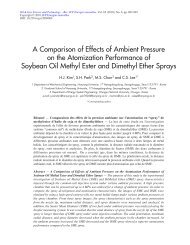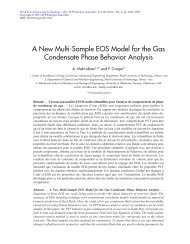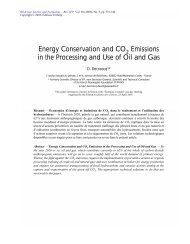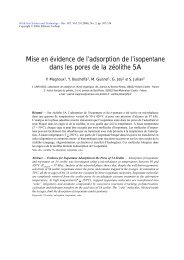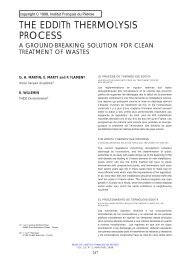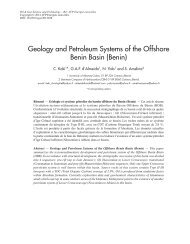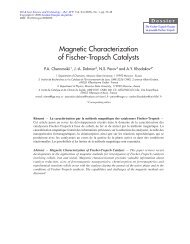Fractured Reservoir Simulation: a Challenging and Rewarding Issue
Fractured Reservoir Simulation: a Challenging and Rewarding Issue
Fractured Reservoir Simulation: a Challenging and Rewarding Issue
Create successful ePaper yourself
Turn your PDF publications into a flip-book with our unique Google optimized e-Paper software.
Oil & Gas Science <strong>and</strong> Technology – Rev. IFP, Vol. 65 (2010), No. 2, pp. 227-238Copyright © 2010, Institut français du pétroleDOI: 10.2516/ogst/2009063Dossier<strong>Fractured</strong> <strong>Reservoir</strong> <strong>Simulation</strong><strong>Simulation</strong> des réservoirs fracturés<strong>Fractured</strong> <strong>Reservoir</strong> <strong>Simulation</strong>:a <strong>Challenging</strong> <strong>and</strong> <strong>Rewarding</strong> <strong>Issue</strong>B. BourbiauxInstitut français du pétrole, IFP, 1-4 avenue de Bois-Préau, 92852 Rueil-Malmaison Cedex - Francee-mail: bernard.bourbiaux@ifp.frRésumé — <strong>Simulation</strong> des réservoirs fracturés : un défi et un enjeu — Au cours des années récentes,la prise de conscience du rôle des fractures sur la production et la récupération des champs est devenue deplus en plus forte au sein de la communauté pétrolière. Aussi beaucoup d’efforts ont-ils été consacrés à ladétection des fractures et à l’analyse de leur impact sur la production. Toutefois, la prise en considérationde ces observations dans les choix de développement des champs passe par la simulation de réservoir.Cet article traite des spécificités propres aux réservoirs fracturés et qui font de leur simulation à la fois undéfi et un enjeu. En effet, l’intégration des fractures dans un modèle de simulation des écoulements n’estpas immédiate en raison du difficile passage à opérer entre l’observation géologique du réseau defractures/failles et le rôle exercé par ce réseau sur des mécanismes de récupération souvent complexes.Sachant de plus que les fractures peuvent aussi bien freiner que promouvoir la production, la simulationdes réservoirs fracturés peut être considérée comme un défi technique de gr<strong>and</strong> enjeu. Cet article décrit cecontexte propre aux réservoirs fracturés en tant qu’introduction à deux articles techniques dédiés à lasimulation de réservoir en double milieu. Bien qu’elle constitue un autre aspect majeur de l’étude de toutréservoir fracturé, la caractérisation géologique des fractures n’est pas discutée ici, mais seulementévoquée en raison d’une intégration croissante des aspects statique et dynamique.Abstract — <strong>Fractured</strong> <strong>Reservoir</strong> <strong>Simulation</strong>: a <strong>Challenging</strong> <strong>and</strong> <strong>Rewarding</strong> <strong>Issue</strong> — The recent yearshave seen a growing awareness of the role played by fractures in petroleum reservoirs production <strong>and</strong>recovery. Hence, much effort was devoted to the diagnosis of fracture presence <strong>and</strong> impact onproduction. However, turning that diagnosis into field development decisions goes through reservoirsimulation. This paper addresses some of the specificities of fractured reservoirs that make that theirsimulation is both challenging <strong>and</strong> rewarding. Indeed, the integration of fractures into a flow simulationmodel is not straightforward because of the existing gap between the geological fault/fracture network<strong>and</strong> the fingerprint of that network on often-complex recovery mechanisms. Considering that fracturesmay impede or enhance production, fractured reservoir simulation may be seen as a technical challengewith potentially-high reward. This paper underlines that specific framework as an introduction to twotechnical articles dedicated to dual-porosity reservoir simulation. Although it constitutes another majoraspect of any fractured reservoir study, the geological characterization of fractures is not discussedherein, but only evoked because of more <strong>and</strong> more integration of static <strong>and</strong> dynamic aspects.
228Oil & Gas Science <strong>and</strong> Technology – Rev. IFP, Vol. 65 (2010), No. 2INTRODUCTION TO FRACTURED RESERVOIRS:SPECIFIC FEATURES – EXAMPLES – ECONOMICCONTRIBUTIONThe occurrence of fractured reservoirs over the world iswell acknowledged. A quite significant proportion of worldoil reserves is commonly assumed to lie in fractured reservoirs,for instance Firoozabadi (2000) gives an estimation ofmore than over 20%. Although not or less reported, the proportionis probably equivalent or higher for fractured gasreservoirs if one takes into account their higher depth in average,often involving a higher occurrence of diagenesis <strong>and</strong>fracturing phenomena.Figures may fluctuate from one author to another becausethe classification of a reservoir as “fractured reservoir” is notstraightforward as it depends on the classification criteria <strong>and</strong>also on the availability of reservoir information related to thepresence of natural fractures. Regarding field exploitation,the determining criterion to consider a reservoir as fracturedis not so much the presence of fractures but rather the impactof those fractures on the flow behaviour of the reservoir subjectedto fluid extraction. Indeed, as Nelson (1985) clearlywarns the reader in his book (“Geologic Analysis ofNaturally <strong>Fractured</strong> <strong>Reservoir</strong>s”), “finding fractures is notenough” because a fractured reservoir is before all “a reservoirin which naturally occurring fractures either have, or arepredicted to have, a significant effect on reservoir fluid floweither in the form of increased reservoir permeability <strong>and</strong>/orporosity or increased permeability anisotropy”.But, by the way, what are the specific features that define afractured reservoir?Specific FeaturesRegarding geology, fractures <strong>and</strong> faults can be defined assurfaces of discontinuity within a rock volume initiated undergiven stress conditions. They can act as conductive flowpathsor on the opposite as barriers, depending on the historyof stress <strong>and</strong> fluid circulation following their genesis. Theyare present at all scales from the 100-km basin scale down tothe centimetre core scale. The existence of fault/fracture networkat different scales was soon identified <strong>and</strong> quantifiedfrom fractal, i.e. self-similar scale-dependent models.Depending on their throw <strong>and</strong> their intrinsic flow properties,faults may then be responsible for creating different compartmentswithin the reservoir, hence their detection <strong>and</strong> characterizationare essential for field delineation. Beyond that fieldappraisal stage, the reservoir engineer is concerned with thefractures or faults crossing a given hydrocarbon reservoir,defined as a fluid-bearing rock volume constituting a uniquehydraulic entity.The present paper addresses that reservoir engineeringframework. Within that framework, a common classificationof fractured reservoirs consists in considering the additionalcontribution of the matrix medium to the overall reservoirporosity <strong>and</strong> permeability. That classification implicitlyassumes a role of fractures on the reservoir permeability, i.e.its productivity. Three main types of fractured reservoirs canthen be defined:– type (a) where the matrix is tight, with fractures ensuringboth the reservoir porosity <strong>and</strong> permeability;– type (b) where the matrix represents most of the reservoirporosity but does not contribute significantly to the overallreservoir permeability <strong>and</strong> productivity;– type (c) where the matrix is porous <strong>and</strong> also contributes tothe reservoir permeability with the fractures.Although flow criteria drive reservoir engineers’ definitionof fractured reservoirs, it remains indispensable to keep inmind some major geological factors driving their occurrence,namely:– at first, the tectonic setting: obviously, reservoirs locatedin structurally-complex provinces are more likely to havebeen subjected to intense deformation with faulting, folding<strong>and</strong> diffuse fracturing at a lower scale;– the lithology: fractured reservoirs can be found in varioussedimentary settings, however, carbonate formations arein average more often fractured than s<strong>and</strong>stone ones, forvarious reasons including different rock mechanical propertiesbut also different susceptibilities to post-depositionevolution of the sediment;– the reservoir age <strong>and</strong> its burial history, since older <strong>and</strong>/ordeeply-buried formations are generally less porous <strong>and</strong>tighter, hence more prone to fracturing.<strong>Fractured</strong> <strong>Reservoir</strong>s ExamplesThe following well-known fractured oil reservoir examplesillustrate typical geological settings of fractured reservoirs:– the Asmari porous limestone formation (Oligocene-Miocene) in the foothills of Zagros mountain in Iran <strong>and</strong>North Iraq holds the most typical fractured carbonatereservoirs of the Middle East, generally of type (b), suchas Haft Kel field with its nearly-60-year history describedby Saïdi (1987);– North Sea chalky reservoirs, including the Ekofisk complex(with oil reserves in Danian <strong>and</strong> Maastrichtian chalks),are another type of fractured reservoirs of type (b) or (c)with a very high contribution of the matrix to the oilreserves <strong>and</strong> also a variable contribution to the reservoirpermeability;– dolomitized <strong>and</strong> karstic or vuggy limestone reservoirs,generally involving a lesser importance of the matrix inthe oil reserves (type (b) to type (a)), are found in a goodnumber of provinces, among which some Mexican carbonateprovinces such as the Campeche gulf with the giantCantarell complex, <strong>and</strong> a good number of North American
B Bourbiaux / <strong>Fractured</strong> <strong>Reservoir</strong> <strong>Simulation</strong>: a <strong>Challenging</strong> <strong>and</strong> <strong>Rewarding</strong> <strong>Issue</strong> 229provinces, such as the Rocky Mountains foothills inWestern Canada, where fractures enhance the productivityof tight low-porosity dolomitized carbonate formations ofPaleozoic age (Mississippian/Devonian carbonates).Karstic reservoirs may not be considered as typical fracturedreservoirs but more as the result of an intense <strong>and</strong>multi-stage diagenesis of some carbonate reservoirs consistingin weathering, dissolution <strong>and</strong> re-crystallizationphenomena. The latter are caused by exogene chemicallyaggressivesolutions that circulate along preferential flowpaths that may be of sedimentary origin like highly-permeablestrata or inter-strata, or of structural origin likefractures. The process results in a complex 3D network ofconduits associated with cavities, vugs of various sizealong those flow paths, whereas the contribution of thematrix, even if it remains porous, tends to become negligibledue to the extreme permeability contrast generated bythat specific diagenesis;– old s<strong>and</strong>stone reservoirs, of Paleozoic age, are often fractured<strong>and</strong> in majority of type (a). The following examples canbe quoted: the giant Amal field in Libya, the Clair field inUK North Sea, many tight Cambrian to Devonian quartzitereservoirs in Algeria, the giant Romachkino field producingfrom Devonian s<strong>and</strong>stones in the Ural-Volga province ofRussia;– to end with this non-exhaustive list of examples, a fewfractured fields are even found in plutonic formations,generally granites, more rarely volcanic rocks (Jatibarangin Indonesia). The most typical one is probably WhiteTiger, the first Vietnamese oil field in size. One can alsomention La Paz field in Venezuela. Actually, the oilreserves of such fields are often shared between sedimentaryreservoirs <strong>and</strong> the underlying altered basement rock.<strong>Fractured</strong> gas fields are less reported because the highmobility (low viscosity) of gas makes the impact of fractureson reservoir production behaviour less apparent than for fracturedoil reservoirs. One can quote a few examples however,like Paleozoic s<strong>and</strong>stone reservoirs in Algeria, the RockyMountains Paleozoic formations already evoked before, severalsmall gas fields (Meillon, etc.) in the South-West ofFrance. Although generally not considered as conventionalgas reservoirs, fractured shale gas reservoirs can also bequoted as they hold potentially-high reserves, especially inNorth America.<strong>Fractured</strong> <strong>Reservoir</strong>s SignificanceMost major oil & gas-producing countries are concernedwith the presence of fractures in their reservoirs. Indeed, inaddition to the few typical examples given above, manyother fractured reservoirs are found in other hydrocarbonprovinces <strong>and</strong> other countries. The presence of fractures<strong>and</strong>/or conductive faults is either acknowledged or suspectedin many carbonate fields of the Middle East platform (inSaudi Arabia, the United Arab Emirates, Qatar <strong>and</strong> Oman),producing from the Permian (Khuff), Upper Jurassic (Arabzone), Cretaceous (Thamama, etc.), Eocene (Damman) formations.China, Central <strong>and</strong> South Asian countries, SouthAmerican countries along the Andean Belt, European countries(Italy, etc.) also produce a substantial amount of oilfrom fractured reservoirs.Considering the share of carbonate reservoirs in worldoil reserves plus the hydrocarbon reserves found in thegenerally-siliceous reservoirs of Paleozoic age, one canreasonably assume that around half of oil reserves arefound in reservoirs where the question of a possible fractureimpact on productivity <strong>and</strong> recovery is worth beingaddressed, although such an impact will turn out to beeffective or sensitive for only a fraction of them, dependingon such important properties as fracture density, connectivity<strong>and</strong> conductivity. This coarse figure stems fromthe shares of carbonate reservoirs, 40%, <strong>and</strong> of primary agereservoirs,13%, in the world oil reserves estimated byPerrodon (1980) on the basis of giant oil fields defined asfields with oil reserves of more than 500 million barrels(around 70 million tons).Beyond the question of considering a reservoir as fracturedor not, the main concern is assessing to which extent thepresence of fractures influences field reserves. The concernabout fault/fracture impact on production <strong>and</strong> recovery hasgrown during the last decade <strong>and</strong> efforts have been madeto forecast potentially-related problems of production. Oneheuristic reason was the occurrence of unexpected productionbehaviour, such as early water breakthroughs, in somefields initially considered as non-fractured. Other technicalreasons include the improved seismic resolution of reservoirstructure <strong>and</strong> discontinuities, the availability of sophisticatedfracture/fault detection tools, <strong>and</strong> the recent capabilities to analyzethose pieces of information <strong>and</strong> integrate them for fieldflow modelling purposes. Nowadays, provided a minimumamount of data, the detection of fractures <strong>and</strong> the evaluation oftheir possible flow impact are carried out earlier in field life tooptimize the placement of wells <strong>and</strong> the recovery methodaccordingly: fracture impact assessment has been carried out aspart of most reservoir engineering studies.A recent published survey from Allan <strong>and</strong> Sun (2003)indicates that the ultimate recovery factor for 56 fracturedoil reservoirs with reliable data ranges from less than 10%to 60-70%, an estimated range already reported byFiroozabadi (2000). Analyzing recovery data into moredetail, the authors conclude that such scattered values arenot only the result of reservoir characteristics, i.e. the fracturenetwork, the aquifer drive <strong>and</strong> the matrix properties,but also the consequence of adequate or inadequate recoverymethods <strong>and</strong> production management. That is, morethan for other types of reservoirs, reserves maximizationcalls for joint efforts of geoscientists <strong>and</strong> reservoir engineers,
230Oil & Gas Science <strong>and</strong> Technology – Rev. IFP, Vol. 65 (2010), No. 2i.e. for an integrated static/dynamic assessment of fractures.Three aspects contribute to that assessment:– a detection <strong>and</strong> diagnosis of the flow-impacting fracturesthanks to meaningful pieces of information;– the transcription, without any loss, of that information intoa reservoir model designed for flow simulation;– the capability of that model to actually simulate reservoirrepresentativerecovery processes.Hereafter, the first two aspects are discussed as a briefintroduction to the ultimate flow simulation step that islargely developed in two dedicated articles of the presentjournal issue.1 USE OF ENGINEERING DATA TO DIAGNOSEFRACTURE IMPACT ON FLOWA review is made of field flow information that may correspondto the “dynamic” expression of fractures. Such indicationsare not sufficient alone to conclude in favour of the presenceof fractures but needs to be confronted to geological information.Apart from image logs <strong>and</strong> production profiles that givea direct evidence of the presence of fractures, the use of otherlogs that may be sensitive to fracture presence <strong>and</strong> propertieswill not be evoked because their interpretation is most alwayscase-specific <strong>and</strong> requires confrontation with other logs orpieces of information.1.1 Engineering Data ReviewVarious basic engineering data are influenced by the presenceof fractures. Starting from initial to advanced stages of fielddevelopment, they include drilling information, productivity/injectivity <strong>and</strong> well test data confronted to matrix-representativecore permeabilities, production logging, <strong>and</strong> later on thefield dynamic history. Regarding that field history, unexpectedevents or a peculiar evolution of production have to bethoroughly analyzed in order to confirm that they actuallyresult from the presence of fractures/faults, rather than fromother flow heterogeneity sources such as sedimentary <strong>and</strong>petrophysical contrasts for instance. The reader’s attention isdrawn again on the necessity to consider the various originsof dynamic responses before concluding on the presence offractures or faults.1.1.1 Drilling InformationMud loss data can now be recorded with sufficient accuracy<strong>and</strong> sudden losses may be due to the presence of a conductivefracture at the considered well depth (Dyke et al., 1995;Verga et al., 2000). These authors determined the hydraulicwidth of a fracture by solving, with a proper fluid rheology,the flow equation within the fracture modelled as the spacebetween parallel walls. Following this approach, they foundthat only fairly-wide fractures, with an hydraulic widthexceeding around 0.2 mm, could be detected.On a qualitative point of view, an increased rate of penetrationmay indicate the presence of fractured levels, with generallya poor core sample recovery for cored wells.1.1.2 Well Flow BehaviourWell TestingTransient flow tests enable to identify <strong>and</strong> characterise flowingfeatures. Regarding fractured/faulted reservoirs, transienttests may give information on the fluid capacity contrast <strong>and</strong>the exchange factor between the fracture <strong>and</strong> matrix media ofa diffusely-fractured porous reservoir, namely of a “dualporosity”reservoir. They may also indicate the presence of afault <strong>and</strong> its distance from wellbore.Whereas theoretical models of fractured reservoirs predicttypical responses, well test data do not often show such abehaviour for several reasons such as wellbore storage effects(unless well is shut in downhole), or an insufficient fracturenetwork connectivity with the wellbore especially in the caseof vertical wells. On the opposite, fields with high permeabilitycontrasts between layers can give well test responses analogousto dual-media responses. At the extreme limit, verythin super-permeable streaks can hardly be dissociated fromfractures due to their low capacity <strong>and</strong> high permeability.Well ProductivityThe overall productivity of a tested well is already a valuableinformation if confronted to other well information, namely,facies <strong>and</strong> fracture distribution along the wellbore, petrophysicaldata measured on core samples, <strong>and</strong> other flow data suchas production logging (PLT, flowmeter). A matrix contributionto the overall formation permeability that is severaltimes less than the fracture contribution leads to suspect thepresence of conductive fractures or of geological objectsequivalent to fractures regarding their impact on flow. Ofcourse, these matrix <strong>and</strong> fracture contributions to reservoirdeliverability have to be evaluated on the same reservoir section.Regarding the evaluation of matrix contribution, thethickness-weighted core permeabilities have to be representativeof the reservoir section under consideration, which maybe problematic in case of missing cores or partial completion.The limited number of interpreted well tests is anotherreason for analysing Productivity Indices (PI) to assess thepossible impact of fractures on production in the differentfield regions. However, because PIs do not only reflect reservoirpermeability but also near-wellbore effects (negative orpositive skin), prior analysis of the latter effects on interpretedwell tests is recommended. As a preliminary/tentativefield diagnosis of fracture impact on flows, the normalised PIvalues (PI divided by completion length) of all the wells canthen be correlated to the fracture density along the completedwellbore section or other possible fracture indicators such asthe distance to the nearest fault.
B Bourbiaux / <strong>Fractured</strong> <strong>Reservoir</strong> <strong>Simulation</strong>: a <strong>Challenging</strong> <strong>and</strong> <strong>Rewarding</strong> <strong>Issue</strong> 231Production LoggingProduction logging of the whole completed section of thewell enables to specify the contribution of each facies to welltest permeability, which can be compared to core-derivedfacies permeabilities in order to derive the contribution offractures to reservoir permeability facies by facies. Thesecontributions can then be confronted to the fracture densitiesmeasured on cores or image logs of the respective facies, inorder to qualify the conductivity of fracture sets defined bythe geologist. An example of such a comparison is shown inFigure 1 for a fractured s<strong>and</strong>stone reservoir (Guaiquirian etal., 2007). This valuable quantification of fracture flowimpact assumes a sufficient sensitivity of the tool response,that is contrasted <strong>and</strong> measurable rates, which discardsheavy/viscous oil reservoirs <strong>and</strong>/or low-conductivity fracturesets.Depth (feet)K.H. (mD.ft)0 500 1000 1500 2000 250014 00014 10014 20014 30014 40014 50014 60014 70014 80014 9000Matrix K.H. (mD. feet)PLT April 2005 x KH testFracture density (frac/m)Non-stimulatedperformationsStimulatedperformations5 10 15Fracture density (frac/m)Figure 1Composite well log confronting:– the fracture density profile derived from borehole image(green);– the cumulative matrix permeability-thickness (KH) product(pink);– the cumulative (fracture + matrix) KH profile derived froma flow-meter log <strong>and</strong> calibrated to the well test KH.(After Guaiquirian et al., 2007).Note that fracture contribution to well production canbe correlated with structural, fault <strong>and</strong>/or facies maps, forsubsequent fracture modelling purposes.1.1.3 Field Production HistoryProduction history is of course an indicator of the effectiverole played by fractures during production, although thereservoir engineer generally wishes to anticipate such effects.Most of the following information may be meaningful interms of fracture flow impact: distribution maps of well productivity/injectivity<strong>and</strong> cumulated production, pressuremaps, fluid contact evolution with time, breakthrough times,trend in the watercut <strong>and</strong> GOR evolution with time. Theanalysis of such reservoir engineering data is becoming commonpractice for fields with sparse fracture information(especially borehole image logs <strong>and</strong> flowmeters) from a fewwells, but a more extensive set of long-term production data.Two recent examples concern Middle East fields (Cosentinoet al., 2002; Ozkaya <strong>and</strong> Richard, 2006) where water injectionresulted in earlier water breakthrough than expected(Fig. 2). Subsequent matrix <strong>and</strong> fracture/fault characterizationwas then undertaken from seismic, wellbore <strong>and</strong> productiondata <strong>and</strong> made possible to identify fracture swarms orcorridors as the conductive features responsible for earlywater breakthrough.For already-developed fields, multiphase productionanalysis is indeed essential for further production optimizationor re-development. The single-phase production timeelapsed before breakthrough at each well has to be correlatedto wellbore fracture data (if available) or to structural data(distance to nearest fault, position in the reservoir structure,etc.). Multiphase production data, such as for instance therate of water-oil ratio increase, can also give informationregarding the contribution of matrix-fracture transfers orcross-flows from low-permeability layers to high-permeabilitystreaks if the fracture origin of water arrival cannot beascertained.For multi-compartment fields, the evolution during productionof pressures <strong>and</strong> fluid composition (oil PVT properties, watersalinity) is also essential to identify possible communicationsbetween reservoir compartments in connection with thepresence of conductive faults.1.2 “Dynamic Fracture” Analysis in PracticeAssessing the presence of fractures <strong>and</strong> their role on flowrequires integrating <strong>and</strong> cross-checking various types ofinformation. A methodological framework is proposedbelow, keeping in mind that it has to be adapted to theamount, type <strong>and</strong> quality of available data:• collection <strong>and</strong> diagnosis of fracture indicators on a wellby-wellbasis. For each well of a given type (horizontal vsvertical, production vs injection, completion type, etc.), all
232Oil & Gas Science <strong>and</strong> Technology – Rev. IFP, Vol. 65 (2010), No. 2Figure 2Irregular water front progression in a giant field crossed by sub-seismic faults: the original position of the water-oil contact is shown as greyb<strong>and</strong>s <strong>and</strong> the present position as blue lines; wet wells are shown as blue circles <strong>and</strong> dry wells as green squares (After Cosentino et al., 2002).available indicators among the following are collected,analysed <strong>and</strong> normalized for comparison purposes:– well-test to core-derived permeability ratio,– mud losses report,– flow rate peaks on production log,– transient well test flow behaviour,– productivity index normalised to completion length (inthe absence of interpreted well test data),– time elapsed before water breakthrough,– cumulative oil production, etc.;• classification of wells according to the quantitative orqualitative values of previously-defined fracture indicators;• mapping the distribution of wells according to fractureindicator values: evidence of field regions or correlationsbetween wells;• interpreting the distribution of fracture indicators valuesover the field through the analysis of other productioninformation such as:– the displacement of fluid contacts with time,– the distribution map of produced fluids composition(water salinity if injected <strong>and</strong> connate/aquifer watercompositions differ),– pressure <strong>and</strong> material balance analysis in the presence ofmultiple reservoirs, etc.;<strong>and</strong> through the integration of geological information such as:– fracture set orientations,– regional stress orientation;• selecting a conceptual flow model of the field that integratesthe flow-impacting fractures that have been identifiedbefore, while taking into account their necessary geologicalinterpretation as recalled at the end of this section;• further quantifying the conductivities of faults or fracturesets intercepting wells where production profiles have beenmeasured along with a core-derived matrix permeabilityprofile.To conclude, many reservoir engineering dynamic datamay be related to the presence of conductive fractures.Obviously, these sources are not often available all togetherfor a given reservoir. In addition, each reservoir case callsfor specific flow diagnosis, for instance the discriminationbetween “useful” <strong>and</strong> non-conductive fracture sets fromproduction logging (Fonta et al., 2007). The methodologydefinitely has to be defined as a function of available fracturerelateddata <strong>and</strong> of the objective assigned to the study.Organising, cross-checking <strong>and</strong> correlating those data isessential to gain a reliable underst<strong>and</strong>ing of fracture impacton field production <strong>and</strong> provide a sound basis for subsequentfield flow modelling. However, their correlation with other“static” information about fractures <strong>and</strong> faults provided bythe geologist remains essential. Actually, the reservoir engineerhas to work in close <strong>and</strong> permanent collaboration withthe geologist:– to properly interpret the origin of preferential flowingfeatures which may be of sedimentary origin in addition toor instead of structural origin, i.e. fracture-related;
B Bourbiaux / <strong>Fractured</strong> <strong>Reservoir</strong> <strong>Simulation</strong>: a <strong>Challenging</strong> <strong>and</strong> <strong>Rewarding</strong> <strong>Issue</strong> 233– to underst<strong>and</strong> the mechanical genesis of fracture sets inorder to predict their distribution within the reservoir;– to identify the origin of determinant fracture propertiessuch as their conductivity, in order to assess the probablefracture flow impact in reservoir zones already characterizedfrom seismic <strong>and</strong> geological information but not yetor sparsely drilled <strong>and</strong> produced;– to properly design acquisition campaigns of furtherdynamic data.If data/information cross-checking concludes in favour ofthe presence of fractures <strong>and</strong> of their effective role on flow,then we have to integrate them into the reservoir flow model.However, that integration cannot be straightforward becausethe fracture network is complex, constituted of fracture setswith different orientations, densities, lengths, conductivities,etc. To deal with that complexity, a conceptual flow modelhas to be selected <strong>and</strong> parameterized in order that reservoirproduction scenarios can be simulated within reasonablecomputation times <strong>and</strong> with a satisfactory reliability.2 SETTING UP A RESERVOIR FLOW MODEL2.1 Selecting a Conceptual Flow Model2.1.1 A <strong>Challenging</strong> IissueSetting up the flow model of a naturally-fractured reservoirremains a challenging issue for the reservoir engineerbecause he has to find a compromise to meet with the followingrequirements:– integrate the geological information regarding the geometry<strong>and</strong> distribution of faults <strong>and</strong> fractures: the link betweenthe geological fracture model <strong>and</strong> the flow model has tobe maintained for the interpretation of the role of fractureson production <strong>and</strong> for subsequent up-dating;– reproduce <strong>and</strong>/or predict the dynamic field response forthe production scenario(s) under consideration: indeed, theimpact of fracture parameters is closely depending on theinvolved recovery mechanism(s);– take into account limited computation capabilities ofindustrial simulation software.Most often, the 3D geological model of faults <strong>and</strong> fracturesis too complex to be used as a direct input for a reservoir simulationsoftware. In fact, typical horizontal <strong>and</strong> verticaldimensions of a reservoir simulator cell are respectively inthe order of the hectometre <strong>and</strong> of the meter-decametre dueto limitations in the size of field-scale numerical models.Within such cells, the centimetric to decametric fractures areassumed to behave like an equivalent medium (Warren <strong>and</strong>Root, 1963), that is, the flow properties of the small-scalefracture network are assumed representative at cell scale <strong>and</strong>describable by a permeability tensor. On the opposite side,hectometric to kilometric faults crossing the reservoir cannotbe incorporated into the equivalent fracture medium definedat cell scale but have to be discretized individually. The intermediatescale of sub-seismic faults <strong>and</strong>/or fracture swarmsposes a specific problem as they are too numerous to be modelledexplicitly <strong>and</strong> too large to behave as an equivalentmedium at simulator cell scale. In addition to their scale, theflow properties of fractures/faults <strong>and</strong> their interactions withthe surrounding medium are determining criteria for thechoice of a representative <strong>and</strong> predictive flow model.Methodological criteria are proposed hereafter, keeping inmind that they have to be tuned to the practical field situationunder consideration <strong>and</strong> to the objectives of the reservoirsimulation study. For instance, the effort to be devoted to aconsistent integration of fracture information into the fieldmodel differs considerably whether one has to simulate ashort depletion history of an under-saturated oil reservoiror the re-development of an already-waterflooded or-gasflooded mature field.Most generally, three criteria drive the choice of aconceptual flow model:– the fracture scale compared to that of model grid cells, thatdetermines the existence of an equivalent fracture mediumat the grid cell scale;– the connectivity of the fracture network <strong>and</strong> the continuityof the matrix medium, that determine the flow continuitybetween cells of a given medium;– the time scale of flow interaction (or transfer) betweenmedia compared to the time scale of fluid transport withina given medium.That is, a hierarchical approach with respect to scale isnecessary but not sufficient. In particular, matrix mediumproperties – permeability, etc. – are also involved as theydetermine the kinetics of interaction between matrix <strong>and</strong>fractures.2.1.2 Our MethodologyLet us explicit our methodology of choice (Fig. 3, afterBourbiaux et al., 2002). We have to deal with two mainmedia, namely matrix <strong>and</strong> fractures of different characteristicscales. The porous medium entities delimited by fractures aredenoted as “matrix blocks” <strong>and</strong> the characteristic dimensionsof these matrix blocks are denoted as the “block size”:– the scales, denoted as l, can be classified with respect tothe model grid cell dimensions, denoted as Δx;– the connectivity/continuity of fracture objects <strong>and</strong> of thematrix medium also has to be taken into account at variousscales;– the kinetics of matrix-fracture interactions has to beassessed in comparison with the fracture medium flow.Let us assume Δt as the typical simulation timestep requiredto describe with a sufficient accuracy the flow progress inthe fracture medium alone. That characteristic time for
234Oil & Gas Science <strong>and</strong> Technology – Rev. IFP, Vol. 65 (2010), No. 2flow in fractures may be of the order of one week ormonth for a field produced over one or few decades. Then,a quasi-static equilibrium of pressure, saturation, compositionor temperature between matrix <strong>and</strong> fracture media canbe reasonably assumed if this equilibrium is establishedwithin a time, t e , that is much less than Δt. The characteristictime for matrix-fracture transfers, t e , can be estimatedfrom analytical solutions, but for simple transfer mechanisms,diffusive for instance, under given initial <strong>and</strong>boundary conditions of the matrix blocks. Otherwise,numerical solutions can be computed on the fine-gridmodel of a matrix block limited by fractures.1st case: fracture scale (average length), l f , is less thancell size, Δx.(1a) Fractures are disconnected: this situation occurs in thepresence of microfractures inducing a permeability anisotropybut no dual-medium flow since the matrix medium is thesingle medium ensuring the flow continuity from one cell toanother. A single-medium model has to be constructed then,with equivalent matrix flow properties that incorporate thelocal contribution of microfractures to cell-scale flow.(1b) Fractures constitute a connected network <strong>and</strong> t e is lessthan Δt: this situation concerns densely-fractured mediadelimiting small matrix blocks that exchange fluids veryrapidly with the fracture network when solicited by the latter.This quasi-static equilibrium between matrix <strong>and</strong> fractures isvery often satisfied in single-phase flow conditions but not sooften in multi-phase conditions. As before, a single-mediummodel can be used with equivalent permeabilities accountingfor the contribution of both media.(1c) Fractures constitute a connected network <strong>and</strong> t e ishigher than Δt: matrix-fracture transfers are delayed withrespect to the fluids transfer taking place in the fracture network.In that case, the use of a dual-medium model is recommendedto reproduce the kinetics of matrix-fracture transfer:– if the fractures delimit blocks that have little or no flowinteraction together, then the matrix medium only acts as alocal source of fluids for the fracture medium <strong>and</strong> a dualporositysingle-permeability approach is well-suited;– but if flow interactions are taking place between successivematrix blocks, either through the existence of porous/non-porous bridges between blocks (“physical” or “staticcontinuity”) or via re-imbibition phenomena (“dynamiccontinuity”), then both the fracture medium <strong>and</strong> the matrixmedium constitute continua for flows between cells: thissituation calls for the adoption of a dual-porosity dualpermeabilitymodel. Such a “dynamic continuity” oftenhas to be taken into account for the simulation of gravitydrivenproduction processes.Although the existence of flow interactions between matrixblocks has been demonstrated <strong>and</strong> quantified from laboratoryexperiments, a priori assessment of such interactions ismuch more speculative when dealing with an undergroundreservoir. The geological history of fractures, including theirdiagenetic phenomena, may be informative but in practice, itis mainly through a sensitivity study of the reservoir historymatch to the assumption of matrix blocks interaction that thechoice between a single- or a dual-permeability model willbe made.2nd case: fractures have an average dimension, l f , close toor exceeding cell size, Δx, but remain far below reservoirscale <strong>and</strong> less than the well spacing.(2a, 2b) Fractures form a connected network: this situationremains similar to previous situations 1b <strong>and</strong> 1c dependingon the rapidity of matrix-fracture transfers (quasi-static equilibriumfor case 2a equivalent to case 1b, <strong>and</strong> slow transfersfor case 2b equivalent to case 1c). In multiphase flow situations,t e is generally higher than Δt, hence the adoption of adual-medium model is often required. In addition, since thedimensions of blocks are of the same order of magnitude orexceed cell size, matrix flows from cell to cell have to betaken into account. That is, situation 2b often calls for thechoice of a dual-porosity dual-permeability model, or at leastmuch more often than in previous case 1c.(2c) Fractures do not constitute a connected network allover the reservoir, some areas being sometimes not fracturedat all: this situation is analogous to previous case 2a in thefractured reservoir regions. Therefore, the dual-mediummodelling approach remains adapted. However, if a singlepermeabilitymodel is selected, the latter should be implementedwithin a simulator that offers the possibility to switchto a matrix single-medium model in non-fractured areas. Thedual-porosity dual-permeability approach intrinsically offerssuch a possibility, as both matrix <strong>and</strong> fracture media are thenconsidered as two continua.Case 2c may correspond to sparsely-distributed sub-seismicfaults or fracture swarms with a pluri-hectometric horizontalscale <strong>and</strong> a high vertical extension. Because of their low tonil throw, they may be undetectable individually fromseismic surveys. However, due to their size <strong>and</strong> their nonuniformdistribution, they may closely influence thereservoir-scale flow behaviour, <strong>and</strong> be the origin of earlyinjected fluid breakthroughs for instance. An accuratesimulation of fluid flows along these large fractures with adual-medium model is required, taking into account inparticular the orientation <strong>and</strong> connectivity of those objectswithin <strong>and</strong> between cells through discrete fracture celltransmissivities (Cosentino et al., 2002). For the abovereasons, sub-seismic faults or fracture swarms remain a weakpoint <strong>and</strong> a real source of uncertainties for fractured reservoirflow model. This justifies collaborative efforts of geologists<strong>and</strong> reservoir engineers to better characterize this type offractures <strong>and</strong> to capture their impact on the productionhistory.
B Bourbiaux / <strong>Fractured</strong> <strong>Reservoir</strong> <strong>Simulation</strong>: a <strong>Challenging</strong> <strong>and</strong> <strong>Rewarding</strong> <strong>Issue</strong> 235Small-scaledisconnected(1a)Small-scaleconnected(1b, 1c)Medium-to-large scaleconnected(2a, 2b)Large-scalesparsely distributed(2c)Field-scaleconductive faults(3)200 m200 m200 m200 mt e < Δtt e > Δt2 km(from Henn et al.,7th ECMOR 2000)Little impactof matrixcapillarycontinuityStrong impact of matrixcapillary continuityAnisotropic1φ model1φ model(with averagedM-F properties)2φ model2φ - 2K model2φ - 2K modelExplicit fault modelcoupled witha 1φ or 2φ modelFigure 3Guiding lines for selecting the flow modelling approach of a fractured reservoir (After Bourbiaux et al., 2002).3rd case: fractures have a dimension, l f , largely exceedingcell size, Δx, <strong>and</strong> constitute major identified conduits,which vertically cross-cut the reservoir with possible throwbetween delimited faults.This situation is encountered in some carbonate fields whereconductive faults contribute to fluid transport at reservoirscale <strong>and</strong> constitute bypass between wells. An explicit representationof those faults is necessary to properly match themultiphase field flow behaviour, that often involves earlybreakthroughs at given well locations. As a discrete representationof each individual fault is computer-intensive, a specific“conductive fault model” (Henn et al., 2004) may beadopted. The segregated flow concept that underlies thatmodel avoids any vertical gridding of conductive faults <strong>and</strong>the related numerical constraints.The various situations described above assume the presenceof fractures/faults crossing a porous matrix. Two particularsituations are worth being mentioned:– non-porous fractured reservoirs: a conventional singlemediummodel is generally well suited; however, if majorfractures control the large-scale flow of fluids producedfrom microfractures <strong>and</strong>/or vugs having no direct accessto macro-fractures, then a dual-porosity approach may stillbe required;– conversely, non-fractured heterogeneous reservoirs includingnumerous high-permeability beds sparsely distributedamong tighter layers: such reservoirs behave like porousfractured reservoirs <strong>and</strong> can be satisfactorily representedby a dual-porosity dual-permeability model.2.2 Assigning Properties to the Flow ModelOnce a modelling approach is chosen, effective or equivalentflow properties have to be assigned to each cell of the simulationmodel. These properties refer to the continuaassumed representative of the actual fractured medium atthe flow model resolution scale, i.e. at the cell (or grid-block)scale.The determination of such effective, or up-scaled, propertieshas long remained a fractured reservoir modelling obstacle.The recent possibility to compute flows on discrete models ofgeological fracture networks (Bourbiaux et al., 1998; Sardaet al., 2002; Matthaï et al., 2007 among other authors) was areal breakthrough that contributed to the effective integrationof fracture geology into fractured reservoir engineering(Sabathier et al., 1998).
236Oil & Gas Science <strong>and</strong> Technology – Rev. IFP, Vol. 65 (2010), No. 2In the following, the determination of the following equivalentparameters is discussed:– for single-porosity models: equivalent permeabilities forboth single-phase <strong>and</strong> multiphase conditions;– for dual-porosity models: equivalent single-phase fracturepermeabilities <strong>and</strong> an equivalent matrix-fracture transferparameter that may consist in the dimensions of an equivalentblock or in a shape factor.Note that for dual-porosity models, the necessity to determinemultiphase effective (up-scaled) parameters is avoided if thetwo following conditions are actually satisfied together:– the multiphase matrix-fracture exchanges taking place atthe cell scale can be formulated through the use of a singleexchange parameter (for instance, a single matrix block ofgiven size <strong>and</strong> shape);– the formulas used to compute the matrix-fracture transferfluxes for a cell represent the involved transfer mechanisms<strong>and</strong> are sufficiently accurate.The predictability improvement of upscaled formulas formultiphase matrix-fracture transfers has long been a matter ofresearch <strong>and</strong> remains a subject of new developments to bettercapture the transient character of exchanges (Bourbiaux etal., 1999; Sarma <strong>and</strong> Aziz, 2006; Lu et al., 2008; van Heel etal., 2008, among numerous authors). Special attention is dedicatedto this question in the two other articles of this journalissue that are dedicated to the state of the art in fracturedreservoir simulation (Lemonnier <strong>and</strong> Bourbiaux, 2010).2.2.1 Effective Properties of a Single-Porosity ModelThe effective properties of a single-porosity model, in particularthe effective permeabilities, have to represent both contributionsof matrix <strong>and</strong> fracture media to flow <strong>and</strong> transport, aswell as matrix-fracture exchanges. However, the approximationof effective permeabilities as the sum of the permeabilitiesof each separate medium is valid only when the twomedia behave as two superposed continua <strong>and</strong> matrix-fracturetransfers are very rapid, i.e. when the two media are inquasi-static equilibrium. Such conditions may not be satisfied,especially in the presence of slowly-interacting media<strong>and</strong>/or in the presence of poorly-connected fractures. In thelatter situation, the determination of the effective permeabilityof both media requires to solve coupled equations describingflow in the discrete model of the fracture network <strong>and</strong> thematrix medium, as proposed for instance by Lough et al.(1997). However, numerical computation of coupled matrix<strong>and</strong> fracture flows on discrete models is not yet conceivablefor field-scale models involving hundreds of thous<strong>and</strong>s tomillions cells. Moreover, the problem of up-scaling matrix<strong>and</strong> fracture flow contributions is still more complex undermultiphase conditions. Actually, the determination of effectivemultiphase permeabilities, or of pseudo-relative permeabilities,has no general solution. Except for situations ofquasi-instantaneous matrix-fracture transfer times, the solutionfor pseudo-relative permeabilities is far from unique as itclosely depends on the flow mechanism under consideration,the fracture flow conditions in terms of rate, or saturation,composition, temperature, <strong>and</strong> on the field flow history.Different conventional methods exist to compute those parameters,such as for instance the numerical resolution ofsteady-state flows on fine-grid models with various fractionalflows of the fluids in presence. However, none of them has ageneral scope of application.For all reasons stated above, dual-medium (or dual-porosity)models are recommended for most fractured reservoirsstudies involving a complex production history.2.2.2 Effective Properties of a Dual-Porosity ModelThe basic cell input of a dual-porosity simulation modelinclude the equivalent fracture permeabilities <strong>and</strong> a matrixfractureexchange parameter. For the sake of consistency,these cell-up-scaled parameters have to be determined fromthe geological model of fractures for each cell or group ofcells. The determination of the (up-scaled) dual-medium flowproperties of fractured media has received considerable attentionfrom researchers in both sectors of petroleum <strong>and</strong> waterresources management. A discussion of these approaches canbe found in L<strong>and</strong>ereau et al. (2001), along with an applicationof the volume averaging method.The first published works generally concerned the determinationof equivalent permeabilities.Equivalent Fracture PermeabilitiesEither analytical or numerical methods can be adopted.Analytical methods as the one proposed by Oda (1985), usethe statistical parameters of fracture sets as calculation input,without requiring any Discrete Fracture Network (DFN)modelling <strong>and</strong> discretization. However, they are valid undercertain conditions, essentially a high density <strong>and</strong> connectivityof the conductive fracture network, which are not always fulfilledin practice. These restrictive conditions motivated thedevelopment of numerical methods, as the ones proposedearly by Long et al. (1985), Cacas et al. (1990), Odling(1992) among other authors. The flow problem addressed bythese authors concerned non-porous fractured media such asgranites, <strong>and</strong> methods differed in the technique of discretizationof the Fracture Network. Basically, numerical methodsfor computing equivalent fracture permeabilities consist insolving a steady-state flow problem on the discrete fracturenetwork with application of Poiseuille’s formula for fractureflows, similarly to a resistor network equivalence problem.More recently, a numerical method inherited from the previousones, but based on a minimum discretization of the DFN,was developed for application to oil <strong>and</strong> gas fractured reservoirengineering studies (Bourbiaux et al., 1998), i.e. fordual-porosity models involving a large number of cells. Forall that, flow computation on large <strong>and</strong>/or complex discretefracture networks remains computer-intensive, even with
B Bourbiaux / <strong>Fractured</strong> <strong>Reservoir</strong> <strong>Simulation</strong>: a <strong>Challenging</strong> <strong>and</strong> <strong>Rewarding</strong> <strong>Issue</strong> 237ever-increasing computational capabilities. For this reason, acomplementary use of analytical <strong>and</strong> numerical methodslooks like an optimal compromise for up-scaling fracture permeabilitiesfor field-scale engineering studies. In this respect,Delorme <strong>and</strong> Bourbiaux (2008) proposed a methodology ofchoice between both methods that is based on a connectivityindex calculated from the statistical parameters of fracturesets as characterized by the geologist. Garcia et al. (2007)made also use of both methods to take into account the scaledependence of effective fracture permeability, whether it iscalculated within one layer or over a stack of layers.Matrix-Fracture Exchange ParameterDepending on the industrial simulator under consideration,the exchange parameter may consist in the dimensions of acharacteristic (or “equivalent”) matrix block or in a shapefactor, the latter being inversely proportional to the square ofthe characteristic block dimension(s). Considering that fracturesare most often sub-orthogonal to bed limits, then thematrix medium presents a certain degree of capillary continuityin the orthogonal direction to bedding planes. Therefore,the equivalent matrix block (or shape factor) determinationproblem turns out to be essentially two-dimensional. Foreach layer or group of layers having similar fracturing features,it consists in identifying a square or rectangular equivalentblock section from the geological fracture network. Tothis end, a fast geometrical method (Sarda et al., 1997) wasdeveloped to compute a characteristic function of matrixfractureexchanges in both the geological <strong>and</strong> the equivalentfractured media. That function expresses the 2D piston-typepenetration of a fluid front into the matrix block(s), as asimplified representation of various possible diffusivemechanisms driving matrix-fracture transfer.Lastly, an equivalent vertical block height may have to beassessed to compute the contribution of gravity forces tomatrix-fracture exchanges at the model cell scale. Thatrequirement concerns the dual-porosity single-permeabilitymodels of reservoirs where the assumption of an interruptedcapillary continuity of matrix blocks is justified by structuralor sedimentary reasons reservoirs such as a significant dip,tight intervals or super-permeable strata. Even though a carefulgeological characterization of reservoir structure <strong>and</strong>facies is helpful to qualitatively assess the matrix flow continuityassumption, uncertainty on equivalent block heightvalues is inevitable <strong>and</strong> necessarily calls for a tuning throughthe history matching of the field production.3 FRACTURED RESERVOIR MODELLING:PROGRESS PERSPECTIVESThe growing awareness of the fracture impact on fieldproduction has been the incentive for significant advances inthe characterization <strong>and</strong> modelling of fractured reservoirs inthe recent years. Geosciences <strong>and</strong> reservoir engineeringintegration resulted in better-constrained flow models offractured reservoirs, <strong>and</strong> unveiled at the same time limitationscalling for further progress:– at an intermediate scale between small-scale diffuse fractures<strong>and</strong> seismic faults, sub-seismic faults <strong>and</strong> fracture swarmsremain a difficult issue, as they can neither be treated aspart of a fracture continuum, nor be defined as discreteobjects: pending their detection by high-resolution seismic,stochastic models of sub-seismic faults need to befurther constrained from other geological information <strong>and</strong>from dynamic data or production history;– high-performance methodologies for characterizing <strong>and</strong>up-scaling the flow properties of fracture networks areneeded to parameterize full-field flow models inheritedfrom ever more complex geological fracture models;– multi-scale expression of natural fracturing calls for flowmodels that couple flow continua <strong>and</strong> discrete objects.Once a field-representative flow model has been set up<strong>and</strong> parameterized, the reliability of a fractured reservoir flowsimulation still depends on the adequate transcription of thephysical flow mechanisms taking place in <strong>and</strong> between theconstitutive media, matrix, fractures <strong>and</strong>/or faults, especiallyfor porous fractured/faulted reservoirs where a dominantshare of the field oil reserves are held in the matrix medium.In this respect, two articles of that journal issue (Lemonnier<strong>and</strong> Bourbiaux, 2010) are dedicated to fractured reservoirsimulation with a specific attention to these matrixfracture/faultinteractions.REFERENCESAllan J., Qing Sun S. (2003) Controls on Recovery Factor in<strong>Fractured</strong> <strong>Reservoir</strong>s: Lessons Learned from 100 <strong>Fractured</strong> Fields,SPE paper 84590 presented at the SPE Annual TechnicalConference <strong>and</strong> Exhibition, Denver, Co.Bourbiaux B., Cacas M.C., Sarda S., Sabathier J.C. (1998) A Rapid<strong>and</strong> Efficient Methodology to Convert <strong>Fractured</strong> <strong>Reservoir</strong> Imagesinto a Dual-Porosity Model, Oil Gas Sci. Technol. – Rev. IFP 53, 6,784-799.Bourbiaux B., Granet S., L<strong>and</strong>ereau P., Noetinger B., Sarda S.,Sabathier J.C. (1999) Scaling Up Matrix-Fracture Transfers in Dual-Porosity Models: Theory <strong>and</strong> Application, SPE Paper 56557presented at the SPE Annual Technical Conference <strong>and</strong> Exhibition,Houston, TX, 3-6 Oct.Bourbiaux B., Basquet R., Cacas M.C., Daniel J.M., Sarda S. (2002)An Integrated Workflow to Account for Multi-Scale Fractures in<strong>Reservoir</strong> <strong>Simulation</strong> Models: Implementation <strong>and</strong> Benefits, SPEPaper 78489 presented at the 10th Abu Dhabi InternationalPetroleum Conference <strong>and</strong> Exhibition (ADIPEC), Abu Dhabi,13-16 Oct.Cacas M.C. et al. (1990) Modeling Fracture Flow With a StochasticDiscrete Fracture Network: Calibration <strong>and</strong> Validation, WaterResour. Res. 26, 3, 479-500.Cosentino L., Coury Y., Daniel J.M., Manceau E., Ravenne C., vanLingen P., Cole J., Sengul M. (2002) Integrated Study of a<strong>Fractured</strong> Middle East <strong>Reservoir</strong> with Stratiform Super-K Intervals -Part 2: Upscaling <strong>and</strong> Dual Media <strong>Simulation</strong>, SPE Reserv. Eval.Eng. (SPE 76642) 5, 1, 24-32.
238Oil & Gas Science <strong>and</strong> Technology – Rev. IFP, Vol. 65 (2010), No. 2Delorme M., Atfeh B., Allken V., Bourbiaux B. (2008) UpscalingImprovement for Heterogeneous <strong>Fractured</strong> <strong>Reservoir</strong> Using aGeostatistical Connectivity Index, Geostats 2008, Santiago, Chile.Dyke C.G., Wu B., Milton-Tyler D. (1995) Advances inCharacterizing Natural-Fracture Permeability from Mud-Log Data,SPE Formation Eval. (SPE 25022), 10, 3, 160-166.Firoozabadi A. (2000) Recovery Mechanisms in <strong>Fractured</strong><strong>Reservoir</strong>s <strong>and</strong> Field Performance, J. Can. Petrol. Technol. 39, 11,13-17.Fonta O., Al-Ajmi H., Verma N.K., Matar S., Divry V., Al-QallafH. (2007) The Fracture Characterization <strong>and</strong> Fracture Modeling of aTight Carbonate <strong>Reservoir</strong> – The Najmah-Sargelu of West Kuwait,SPE Reserv. Eval. Eng. 10, 6, 695-710.Garcia M, Gouth F., Gosselin O. (2007) Fast <strong>and</strong> EfficientModeling <strong>and</strong> Conditioning of Naturally <strong>Fractured</strong> <strong>Reservoir</strong>Models Using Static <strong>and</strong> Dynamic Data, SPE Paper 107525 presentedat the SPE Europec/EAGE Annual Conference <strong>and</strong>Exhibition, London, UK, 11-14 June.Guaiquirian L., Gonzalez P., Gonzalez A., Manuela Hern<strong>and</strong>ez M.,Le Maux T., Mattioni L., Rouvroy P. (2007) Use of DiscreteFracture Network ‘DFN’ to Characterize <strong>and</strong> Model a Naturally<strong>Fractured</strong> S<strong>and</strong>stone <strong>Reservoir</strong>: Orocual Field, San Juan Formation,Venezuela – A Case Study, SPE Paper 108052 presented at the SPELatin American <strong>and</strong> Caribbean Petroleum Engineering Conference,Buenos Aires, Argentina, 15-18 April.van Heel A.P.G., Boerrigter P.M., van Dorp J.J. (2008) Thermal <strong>and</strong>Hydraulic Matrix-Fracture Interaction in Dual-Permeability<strong>Simulation</strong>, SPE Reserv. Eval. Eng. 11, 4, 735-749.Henn N., Quintard M., Bourbiaux B., Sakthikumar S. (2004)Modelling of Conductive Faults With a Multiscale Approach, OilGas Sci. Technol. – Rev. IFP 59, 2, 197-214.L<strong>and</strong>ereau P., Noetinger B., Quintard M. (2001) Quasi-Steady Two-Equation Models for Diffusive Transport in <strong>Fractured</strong> PorousMedia: Large-Scale Properties for Densely <strong>Fractured</strong> Systems, Adv.Water Resour. 24, 8, 863-876.Lemonnier P., Bourbiaux B. (2010) <strong>Simulation</strong> of Naturally<strong>Fractured</strong> <strong>Reservoir</strong>s. State of the Art: Part 1 – PhysicalMechanisms <strong>and</strong> Simulator Formulation, Oil Gas Sci. Technol. –Rev. IFP (to be published).Lemonnier P., Bourbiaux B. (2010) <strong>Simulation</strong> of Naturally<strong>Fractured</strong> <strong>Reservoir</strong>s. State of the Art: Part 2 – Matrix-FractureTransfers <strong>and</strong> Typical Features of Numerical Studies, Oil Gas Sci.Technol. – Rev. IFP (to be published).Long J.C.S., Gilmour P., Witherspoon P.A. (1985) A Model forSteady Fluid Flow in R<strong>and</strong>om Three-Dimensional Networks ofDisc-Shaped Fractures, Water Resour. Res. 21, 8, 1105-1115.Lough M.F., Lee S.H., Kamath J. (1997) A New Method toCalculate Effective Permeability of Gridblocks Used in the<strong>Simulation</strong> of Naturally <strong>Fractured</strong> <strong>Reservoir</strong>s, SPE Reserv. Eng. 12,3, 219-224.Lu H., Di Donato G., Blunt M.J. (2008) General Transfer Functionsfor Multiphase Flow in <strong>Fractured</strong> <strong>Reservoir</strong>s, SPE J. 13, 3, 289-297.Matthäi S.K., Mezentsev A., Belayneh M. (2007) Finite Element-Node-Centered Finite-Volume Two-Phase Flow Experiments with<strong>Fractured</strong> Rock Represented by Unstructured Hybrid-ElementMeshes, SPE Reserv. Eval. Eng. 10, 6, 740-756.Nelson R.A. (1985) Geological analysis of naturally fracturedreservoirs, Chilingar G.V. (Ed.), Contributions in PetroleumGeology & Engineering, 1, Gulf Publishing Company.Oda M. (1985) Permeability Tensor for Discontinuous RockMasses, Géotechnique 35, 4, 483-495.Odling N.E. (1992) Permeability of Natural <strong>and</strong> Simulated FracturePatterns, Structural <strong>and</strong> Tectonic Modelling <strong>and</strong> its Application toPetroleum Geology, Elsevier, Norwegian Petroleum Society (NPF),NPF Special Publication 1, 365-380.Ozkaya S.I., Richard P.D. (2006) <strong>Fractured</strong> <strong>Reservoir</strong>Characterization Using Dynamic Data in a Carbonate Field, Oman,SPE Reserv. Eval. Eng. 9, 3, 227-238.Perrodon A. (1980) Géodynamique Pétrolière, Masson & Cie.Sabathier J.C., Bourbiaux B., Cacas M.C., Sarda S. (1998) A NewApproach of <strong>Fractured</strong> <strong>Reservoir</strong>s, SPE Paper 39825 prepared forthe SPE International Petroleum Conference <strong>and</strong> Exhibition,Villahermosa, Mexico, 3-5 March.Saidi A.M. (1987) <strong>Reservoir</strong> Engineering of <strong>Fractured</strong> <strong>Reservoir</strong>s,TOTAL Edition Presse, Paris.Sarda S., Bourbiaux B., Cacas M.C., Sabathier J.C. (1997) AnInnovative Procedure to Compute Equivalent Block Size in a Dual-Porosity Model, Paper presented at the 9th European Symposium onImproved Oil Recovery, The Hague, The Netherl<strong>and</strong>s, 20-22 Oct.Sarda S., Jeannin L., Basquet R., Bourbiaux B. (2002) HydraulicCharacterization of <strong>Fractured</strong> <strong>Reservoir</strong>s: <strong>Simulation</strong> on DiscreteFracture Models, SPE Reserv. Eval. Eng. 5, 2, 154-162.Sarma P., Aziz K. (2006) New Transfer Functions for <strong>Simulation</strong> ofNaturally <strong>Fractured</strong> <strong>Reservoir</strong>s with Dual-Porosity Models, SPE J.11, 3, 328-340.Verga F.M., Carugo C., Chelini V., Maglione R., De Bacco G.(2000) Detection <strong>and</strong> Characterization of Fractures in Naturally<strong>Fractured</strong> <strong>Reservoir</strong>s, SPE Paper 63266 presented at the SPEAnnual Technical Conference <strong>and</strong> Exhibition, Dallas, Tx, 1-4 Oct.Warren J.E., Root P.J. (1963) The Behavior of Naturally <strong>Fractured</strong><strong>Reservoir</strong>s, SPE J. Sept., 245-255.Final manuscript received in June 2009Published online in March 2010Copyright © 2010 Institut français du pétrolePermission to make digital or hard copies of part or all of this work for personal or classroom use is granted without fee provided that copies are not madeor distributed for profit or commercial advantage <strong>and</strong> that copies bear this notice <strong>and</strong> the full citation on the first page. Copyrights for components of thiswork owned by others than IFP must be honored. Abstracting with credit is permitted. To copy otherwise, to republish, to post on servers, or to redistributeto lists, requires prior specific permission <strong>and</strong>/or a fee: Request permission from Documentation, Institut français du pétrole, fax. +33 1 47 52 70 78,or revueogst@ifp.fr.



